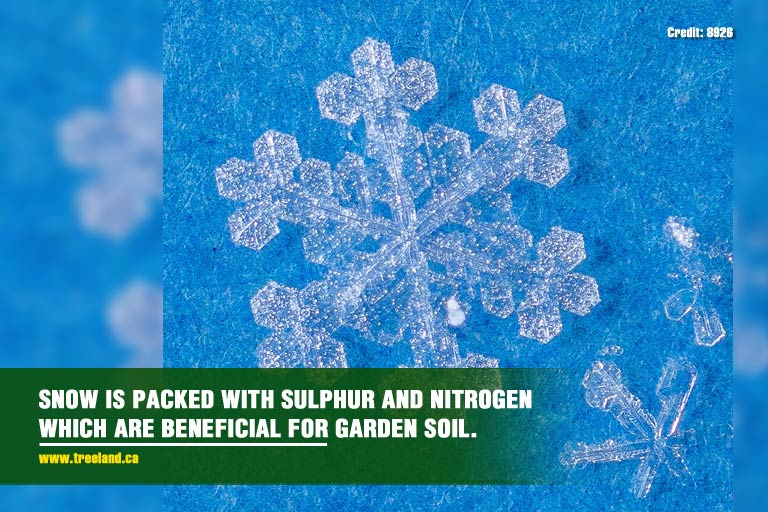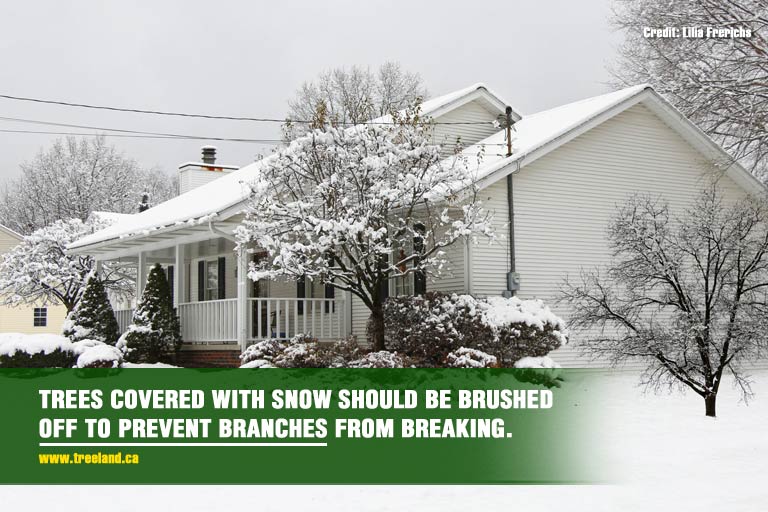
The famous Aristotle once said, “To appreciate the beauty of a snowflake, it is necessary to stand out in the cold.” It simply feels magical to stand outside with fluffy flakes falling. We enjoy the first fall of snow and the pristine white blanket of snow all around us. A snow-covered garden can look peaceful and still.
The Good and Bad of Snow
Winter is upon us once again. Snow can be beautiful and beneficial to your garden, but it could also spell trouble for your plants. Let us take a look at how snow can help and harm your garden and plants.
The Good:

Too much or too little of something can be bad. The same goes when it comes to snow. While snow can damage plants, it turns out that plants can benefit from the blanket of snow.
- That blanket of snow acts as an insulator. Think of it as one big fluffy down jacket that protects new growth from extreme cold and strong winds while keeping the plants moist and preventing soil from freezing and damaging its root system. It effectively holds heat by creating pockets of trapped air inside.
- It protects the ground from the freeze/thaw cycle. With a good blanket of snow, the temperature of the soil can stay at 32 degrees despite the lower air temperature. By maintaining a consistent temperature, it prevents the ground from heaving and thawing.
- Your trees were born for it. Okay, “born” is the wrong word, but you understand the idea. Many trees, especially local, indigenous ones, are adapted well to our snowy conditions. Under persistent snow cover, new roots can develop and grow using the tree stored energy reserves.
- It helps (some) trees to thrive. Have you ever wondered why evergreens retain their green growth, while deciduous trees shed their leaves in the fall? They’re still photosynthesizing during the winter. The whiteness of the snow can reflect sunlight, giving the plants enough reflected sunlight to continue photosynthesis throughout the winter.

It is full of yummy goodness (for trees). Snow is a natural fertilizer that magically comes from the sky. Sulphur and nitrogen compounds attach to its crystals as the snowflakes formulate high in the atmosphere, and even more, will accumulate to the flakes as they fall. These nutrients are later released to the garden soil as it melts.
The Bad:

- It’s very heavy. The biggest problem caused by snow to your plants is the weight it puts on their branches and/or leaves. As heavy snow falls and starts to pile on the plant, the weight can bend and eventually snap smaller branches. This puts brittle young plants, as well as old shrubs and trees, susceptible to fall or become uprooted.
- It’s dangerous. When weak branches break, it can potentially hurt and/or injured a passerby or cause serious damage to your roof. Repeated freezing and thawing could result in plants heaving out of the soil, as well as damage to your flower buds.
- It’s hard to get enough water. Evergreen trees often have a hard time absorbing water from the frozen soil. Also, when snow reflects sunlight, it draws out moisture from their leaves. When the snow melts, it provides water to winter-thirsty plants, but it becomes a problem when it thaws quickly and forms ice around the plants.
- It provides pest with protection. While the thick blanket of snow protects shrubs, trees, and perennials, it also shelters harmful animals. Voles can tunnel under the snow and secretly chew on barks and stems of plants. Many garden pests, like snails, slugs, and aphids, can survive quite well through winter. A pile of snow can also give rabbits a leg up to reach higher branches. This allows the rabbit to feast on young stems.
- Temperature fluctuations can cause permanent damage. Exposure to cold, dry winter wind and sun can cause yellowing and bronzing of some evergreen needles. In most cases, the needles will regain their standard colour when new growth resumes in the spring.
Severe, prolonged, or sudden changes in temperature can cause permanent damage to your tree. A drastic drop in temperature after a mid-winter thaw could result in the tree’s bark splitting. Tissue death can occur when the plant is unable to replace the lost moisture drawn out from the needles.
Protecting Your Plants From Winter Conditions

Here are a few helpful things that you can do to help your garden’s trees to overwinter successfully (and give you peace of mind during the cold winter months):
- Improve your soil’s drainage – Proper soil drainage is essential in the winter season as it prevents standing pools of icy water. Avoid chemical fertilizers. Use organic matter instead, including compost, leaf mulch, bark chips, well-rotted manure, sawdust, straw, or shredded seaweed. This creates an organic bedrock in your garden.
- Clear away excess snow – When large volumes of snow start to accumulate on evergreen trees, it adds unnecessary weight to the branches, causing it to bend and break. To protect the branches, brush off the snow using a household broom to remove the load from the plant.

- Cover your plants – Protect your plants against frost injury by covering it before nightfall with an old blanket, burlap sacks, and sheets. However, any type of covering will do. Drape them loosely over the plant and secure it with stakes, rocks, or bricks to keep them in place.
When using heavy covers, make sure to use a support, such as wire, to prevent it from crushing and damaging the plant under its weight. Covering young, tender plants at night prevents heat from escaping to protect them from freezing. Do not forget to remove the cover in the morning to prevent them from suffocating.
- Mulch your plants – Many gardeners mulch their garden plants to lock in moisture and hold heat during the winter. However, keep in mind that not all tender plants can benefit from mulching. Cover them instead to protect them from frost injury. When mulching, use organic materials, such as leaves, pine needles, bark, and straw. Keep the mulch at a depth of about two or three inches.
- Water plants before a frost – This may sound outrageous, but watering around plants a day or two before frost is a good idea. Wet soil holds more heat than dry soil. It is not recommended to saturate the plants, especially at extremely low temperatures to prevent frost heave, which causes injury to the plants. Water plants lightly in the evening before the temperature drops to release moisture in the air, increase temperature, and keep the plants warm.
- Wrap fragile trees with weatherproofing – Trees are prone to frost crack. A thin back can easily split when the temperature drastically fluctuates. Wrap the tree with multiple layers of cloth or weatherproof paper a little loose. The cover acts as an insulation. The wrapping should be as high as the lower branches and extending all the way to the ground. Leave the wrapping on for the majority of the winter season if necessary.
Make sure to be ready and well-informed before the first fall of snow occurs. Taking care of your saplings, shrubs, and trees in the winter ensures a beautiful garden or landscape in spring.
If you want to buy trees for sale in Toronto, make sure to talk to a certified arborist about how to take care of them during the winter season. Choose trees for sale that are able to adapt well in cold temperatures.
Call Caledon Treeland at (905) 880-1828 to book a tour on our GTA tree farm.
